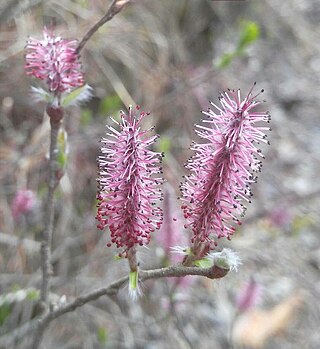
Willows, also called sallows and osiers, of the genus Salix, comprise around 350 species of typically deciduous trees and shrubs, found primarily on moist soils in cold and temperate regions.

Gracillariidae is an important family of insects in the order Lepidoptera and the principal family of leaf miners that includes several economic, horticultural or recently invasive pest species such as the horse-chestnut leaf miner, Cameraria ohridella.
The Catalogue of Life is an online database that provides an index of known species of animals, plants, fungi, and microorganisms. It was created in 2001 as a partnership between the global Species 2000 and the American Integrated Taxonomic Information System. The Catalogue is used by research scientists, citizen scientists, educators, and policy makers. The Catalogue is also used by the Biodiversity Heritage Library, the Barcode of Life Data System, Encyclopedia of Life, and the Global Biodiversity Information Facility. The Catalogue currently compiles data from 165 peer-reviewed taxonomic databases that are maintained by specialist institutions around the world. As of September 2022, the COL Checklist lists 2,067,951 of the world's 2.2m extant species known to taxonomists on the planet at present time.

Salix glauca is a species of flowering plant in the willow family known by the common names gray willow, grayleaf willow, white willow, and glaucous willow. It is native to North America, where it occurs throughout much of Alaska, northern and western Canada, and the contiguous United States south through the Rocky Mountains to northern New Mexico. It can also be found in Greenland, northwestern Europe, and Siberia.
Utricularia capillacea is a species of carnivorous plant from the Lentibulariaceae family, Lamiales order, described by Carl Ludwig Willdenow. According to the Catalogue of Life Utricularia capillacea does not have known subspecies.

Salix repens, the creeping willow, is a small, shrubby species of willow in the family Salicaceae, growing up to 1.5 metres in height. Found amongst sand dunes and heathlands, it is a polymorphic species, with a wide range of variants. In the UK, at least, these range from small, prostrate, hairless plants at one end of the spectrum to taller, erect or ascending silky-leaved shrubs at the other. This wide variation in form has resulted in numerous synonyms.

Anisoptera thurifera is a tree species in the family Dipterocarpaceae. This Asian species has been recorded from Bangladesh through to New Guinea; the IUCN has categorised it as Vulnerable.

Lyonia ferruginea, the rusty staggerbush, tree lyonia, dragon tree, is a plant of the genus Lyonia. It was first described by Thomas Walter, and was named by Thomas Nuttall. No subspecies are listed in the Catalog of Life.
Allium drobovii is a species of onion native to the southwestern spurs of the Talas Alatau and the Karatau Mountains in Kazakhstan and Uzbekistan. The plant is in the amaryllis family, originally described by Alexei Ivanovich Vvedensky. A. drobovii does not have any subspecies listed in the Catalog of Life.

Stylidium piliferum is a species of dicotyledonous plant from the genus Stylidium. It is found in Western Australia.

Silene sorensenis, the three-flowered campion or Sorensen's catchfly, is a species of plant in the family Caryophyllaceae. It is found in the tundra of the Canadian Arctic Archipelago, the Northern Russian Far East and Greenland.
Salix uralicola is a willow species described by I. V. Belyaeva. No subspecies are listed in the Catalog of Life.

Salix waldsteiniana, the Waldstein willow, is a species of willow native to Europe.
Carya palmeri, the Mexican hickory, is a tree species native to Mexico. It was first described by Wayne Eyer Manning. Carya palmeri is part of the genus Carya, and the family Juglandaceae.
Carya poilanei is a very large species of hickory native to northern Laos, northern Vietnam, Thailand, and southern China. It was first described by Auguste Jean Baptiste Chevalier, and given its current name by André Leroy. Carya poilanei is part of the genus Carya, and the family Juglandaceae.

Salix saxatilis is a willow species described by Porphir Kiril Nicolai Stepanowitsch Turczaninow.
Salix nuristanica is a species of willow which was described by A.K.Skvortsov in 1965.
Salix athabascensis is a species of willow first described by Hugh Miller Raup.
Salix pantosericea is a species of willow first described by Görz in 1934 from the Caucasus region.

Salix euxina, the eastern crack-willow, is a species of flowering plant in the willow family Salicaceae, native from Turkey to the Caucasus. It was first described by I. V. Belyaeva in 2009. It is one of the parents of the common crack-willow, Salix × fragilis.











